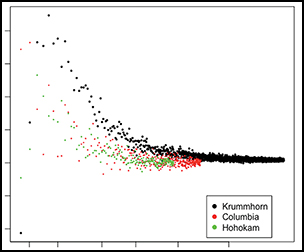Article contents
Comparing ancient inequalities: the challenges of comparability, bias and precision
Published online by Cambridge University Press: 12 August 2019
Abstract

Archaeological evidence provides the only basis for comparative research charting wealth inequality over vast stretches of the human past. But researchers are confronted by a number of problems: small sample sizes; variable indicators of wealth (including individual grave goods, the area of household dwellings or storage spaces); overrepresentation of the wealthy, or invisibility of those without wealth; and vastly different population sizes. Here, the authors develop methods for estimating the Gini coefficient—a measure of wealth inequality—that address these challenges, allowing them to provide a set of 150 comparable estimates of ancient wealth inequality.
Information
- Type
- Research
- Information
- Copyright
- Copyright © Antiquity Publications Ltd, 2019
References
Atkinson, A. & Piketty, T.. (ed.). 2007. Top incomes over the twentieth century: a contrast between continental Europe and English-speaking countries. Oxford: Oxford University Press.Google Scholar
Bogaard, A., Fochesato, M. & Bowles, S.. In press. The farming-inequality nexus: new methods and archaeological evidence. Antiquity 93.Google Scholar
Gudeman, S. & Rivera, A.. 1990. Conversations in Colombia: the domestic economy in life and text. Cambridge: Cambridge University Press. https://doi.org/10.1017/CBO9780511558009Google Scholar
Herlihy, D. & Klapisch-Zuber, C.. 1985. Tuscans and their families: a study of the Florentine catasto of 1427. New Haven (CT): Yale University Press.Google Scholar
Kohler, T.A. & Higgins, R.. 2016. Quantifying household inequality in Early Pueblo villages. Current Anthropology 57: 690–97. https://doi.org/10.1086/687982Google Scholar
Kohler, T.A. & Smith, M.. (ed.). 2018. Ten thousand years of inequality: the archaeology of wealth differences. Tucson: University of Arizona Press.Google Scholar
Kohler, T.A. et al. 2017. Greater post-Neolithic wealth disparities in Eurasia than in North America and Mesoamerica. Nature 551: 619–22. https://doi.org/10.1038/nature24646Google Scholar
Kuznets, S. 1965. Economic growth and income inequality. American Economic Review 65: 1–28.Google Scholar
McGuire, R.H. 1992. Death, society and ideology in a Hohokam community. Boulder (CO): Westview.Google Scholar
Morris, I. 2010. Why the West rules—for now. The patterns of history, and what they reveal about the future. New York: Farrar, Straus & Giroux.Google Scholar
Nadel, D. 2003. The Ohalo II brush huts and the dwelling structures of the Natufian and PPNA sites in the Jordan Valley. Archaeology, Ethnology & Anthropology of Eurasia 1: 34–48.Google Scholar
Nummela, I. 2011. Regional inequality, in Lamberg, M.H. & Haikari, J. (ed.) Physical and cultural space in pre-industrial Europe. Methodological approaches to spatiality: 335–74. Lund: Nordic Academic.Google Scholar
Peterson, C.E. & Drennan, R.D.. 2018. Letting the Gini out of the bottle: measuring inequality archaeologically, in Kohler, T.A. & Smith, M.E. (ed.) Ten thousand years of inequality: the archaeology of wealth differences: 39–66. Tucson: University of Arizona Press. https://doi.org/10.2307/j.ctt20d8801.5Google Scholar
Porčić, M. 2018. Evaluating social complexity and inequality in the Balkans between 6500 and 4200 BC. Journal of Archaeological Research 2018: 1–56. https://doi.org/10.1007/s10814-018-9126-6Google Scholar
Prentiss, A.M., Foor, T.A. & Murphy, M.-M.. 2018. Testing hypotheses about emergent inequality (using Gini coefficients) in a complex fisher-forager society at the Bridge River site, British Columbia, in Kohler, T.A. & Smith, M.E. (ed.) Ten thousand years of inequality: the archaeology of wealth differences: 96–129. Tucson: University of Arizona Press. https://doi.org/10.2307/j.ctt20d8801.7Google Scholar
Scheidel, W. 2017. The great leveller: violence and the history of inequality from the Stone Age to the twenty-first century. Princeton (NJ): Princeton University Press. https://doi.org/10.1515/9781400884605Google Scholar
Schulting, R.J. 1995. Mortuary variability and status differentiation on the Columbia-Fraser Plateau. Burnaby: Archaeology Press, Simon Fraser University.Google Scholar
Stone, E.M. 2018. The trajectory of social inequality in ancient Mesopotamia, in Kohler, T.A. & Smith, M.E. (ed.) Ten thousand years of inequality: the archaeology of wealth differences: 230–61. Tucson: University of Arizona Press. https://doi.org/10.2307/j.ctt20d8801.12Google Scholar
Trigger, B.G. 2003. Understanding early civilizations. Cambridge: Cambridge University Press. https://doi.org/10.1017/CBO9780511840630Google Scholar
Willführ, K.P. & Störmer, C.. 2015. Social strata differentials in reproductive behavior among agricultural families in the Krummhörn region (East Frisia, 1720–1874). Historical Life Course Studies 2: 58–85.Google Scholar
Windler, A., Thiele, R. & Müller, J.. 2013. Increasing inequality in Chalcolithic South-east Europe: the case of Durankulak. Journal of Archaeological Science 40: 204–10. https://doi.org/10.1016/j.jas.2012.08.017Google Scholar
- 56
- Cited by

